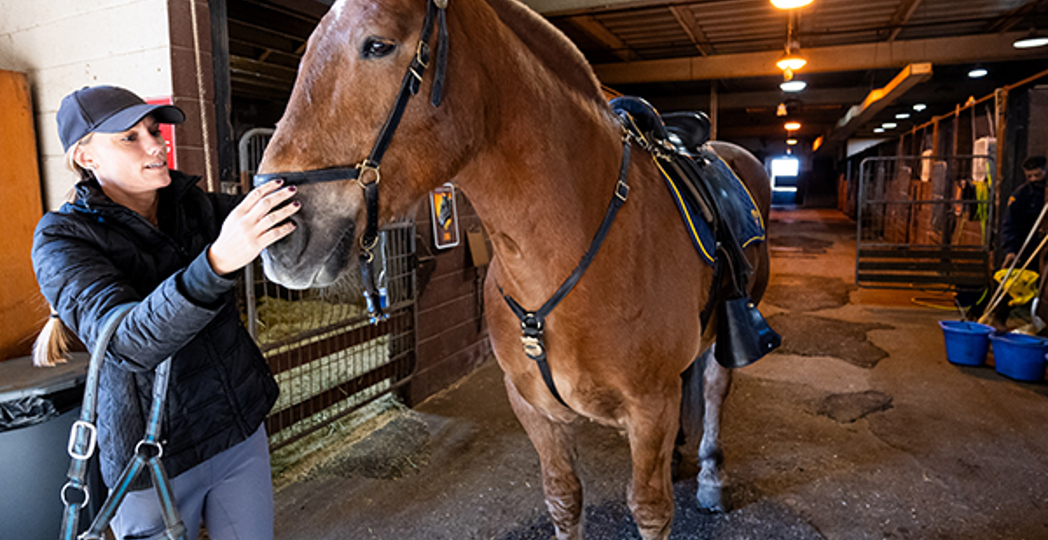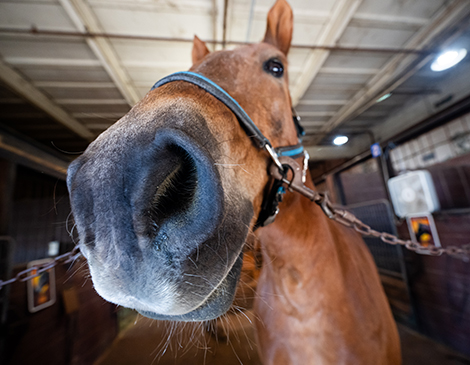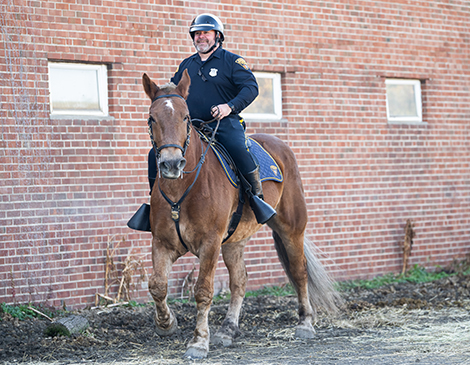For more updates about Cleveland, sign up for our Cleveland Magazine Daily newsletter, delivered to your inbox six times a week.
Should Cleveland Spend $13 Million for Police Mounted Unit?
by Robin Goist | Dec. 5, 2023 | 10:00 AM

Ken Blaze
Officer Chuck Lipscomb’s nose wrinkles as he’s hit with the smells of fresh hay and horse manure. Such barnyard aromas aren’t common in the city of Cleveland, but they permeate each day here at the Cleveland Police Mounted Unit stables.
Lipscomb, a motorcycle officer, has been working at the stables part time for the past few years. He introduces me to his usual horse: Jim, a beautiful, brown draft horse. “Jim is really kind of quiet and more laid-back,” Lipscomb says. “I’ve had him at several events, and on the streets, he’s really easy to introduce to people.”
A loud clang comes from a bolder personality: George, a black-and-white horse, banging his hoof against the door of his stall, signaling that he’s ready to run outside. Max, the “foodie” of the bunch, chows down on hay; well-mannered Larry watches quietly; and Breeze, who is soon to be retired due to an injury, relaxes in the back of her stall.
Located on East 38th Street, just south of the Shoreway, the 75-year-old stables became a topic of local political intrigue earlier this year, when Mayor Justin Bibb’s administration considered spending $13 million rebuilding them. The current building will need to be torn down as part of the Dead Man’s Curve improvement project, so if the Mounted Unit continues to exist, the horses will need a new home.
“If we got a new facility, we could have an indoor arena where we could have Christmas or Halloween parties for kids,” says Commander Gordon Holmes, who oversees the motorcycle and mounted units. “We want it to be a place where you can bring your kids or your grandkids.”

The $13 million price tag was eye-popping, especially since the mounted unit only has six horses. The Bibb administration has put the project on hold and is reviewing its options, a spokesperson says. Each year, the city pays for the horses’ veterinary care, food, training and farrier services. The city spokesperson could not provide the total amount of those costs. A foundation called The Cleveland Mounted Police Charitable Trust covers other expenses, including purchasing new horses for the unit.
Yet, the very necessity of a mounted police unit in 2023 is questionable. Far gone are the days of officers needing to chase down suspects on horseback. In recent years, the department has deployed its mounted unit mostly for maintaining a noticeable presence at parades, sporting events, public festivities and protests — about 200 events per year, Holmes says.
“In a riotous situation, there’s nothing better than [horses] to clear things out,” Holmes says. “From a community relations standpoint, what price do you put on it? What price do you put on a little kid coming up with his mom who doesn’t trust the police? I think the benefits far outweigh the costs.”
Some residents who are rethinking public safety have raised concerns about whether funding the mounted unit is the best use of taxpayer dollars. After all, the unit has existed for more than a hundred years, and despite that, the city has struggled with police brutality, a federal consent decree and a culture of distrust of the police.
“Community policing is often trotted out — no pun intended — as a way to smooth the relations between this violent institution and the communities in which they exist,” says C Stonebraker-Martinez, co-executive director of the InterReligious Task Force on Central America and Colombia.

It’s ironic, Stonebraker-Martinez says, how the proposed $13 million price tag for the stables was almost exactly what People’s Budget CLE requested for one year’s worth of participatory budgeting. “And some people are very concerned about where that money is going to come from,” they say, “but if you really look under the covers, you can see millions of dollars are wasted on various things that our community never asked for or doesn’t need, like a mounted police unit.”
Josiah Quarles, director of organizing with the Northeast Ohio Coalition for the Homeless, questioned the ethics of the new stables amounting to about $2 million per horse, “when we don’t have adequate housing for human beings in our city.”
Putting public dollars toward housing, education and health care, he says, is more impactful for public safety than “throwing money at antiquated ideas like mounted police.”
Stonebraker-Martinez says they would like to see the horses moved to a farm, “where they can have a beautiful life,” rather than locked up in a corner of the city.
Amy Stewart, co-founder of Cleveland Animal Save, also takes issue with the use of horses for police work, pointing to how horses are naturally prey animals that can be easily scared and traumatized by loud noises or changes in their environment.
“We’re forcing these animals into the literal line of fire, and they can get injured or even killed in the line of duty,” Stewart says. “Human police officers know what they’re signing up for, but these horses didn’t sign up for any of this. They didn’t have a choice, they didn’t get a say, and we’re just making them and putting them in these really dangerous situations against their will.”
Back at the stables, Holmes and Lipscomb introduce me to the newest horse, named Leonard — at least, for now, as they consider calling him “Cavalier,” or holding a public naming contest on social media. Leonard still has his long mane — the horses in the unit have their manes routinely “roached” or shaved — and lives in a stall secluded from the other horses. He is quarantining and will be slowly introduced to see if he fits into the herd; not every horse is right for the unit, the trainer says.
Leonard’s future remains in limbo, between this stable, a new facility or green pastures — just as the future of Cleveland’s mounted police stables hangs in the balance.
Trending
-
1
-
2
-
3
-
4
-
5










